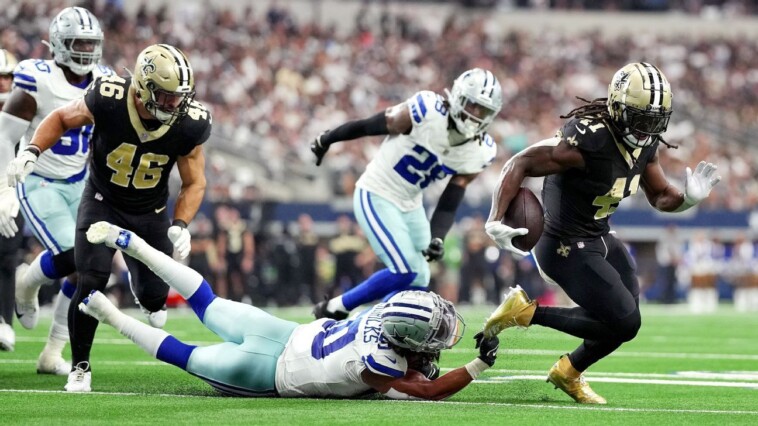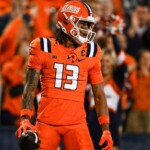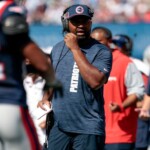-

Ben Solak, ESPNSep 19, 2024, 06:30 AM ET
- Ben Solak joined ESPN in 2024 as a national NFL analyst. He previously covered the NFL at The Ringer, Bleeding Green Nation and The Draft Network.
There are so many different offenses to fear in the NFL. The elite quarterbacks: Patrick Mahomes, Josh Allen. The dual-threat quarterbacks: Lamar Jackson, Jalen Hurts. The elite schemers: Kyle Shanahan, Sean McVay. The star wideouts with takeover potential: Justin Jefferson, Tyreek Hill. And of course, the New Orleans Saints, who have scored 4.33 points per drive to start the season. (The best offense this century, the 2007 Patriots, finished the season at 3.19.) The 15 consecutive scoring drives quarterback Derek Carr strung together to start the season is the longest streak since 1978, according to the Elias Sports Bureau. No biggie.
Even the most optimistic Saints fan did not have this on their bingo card: a 47-10 drubbing over the listless Carolina Panthers chased by a 44-19 statement win at AT&T Stadium against the Dallas Cowboys. The Saints were 25th on our preseason Power Rankings, with coach Dennis Allen firmly on the hot seat. Allen’s defense still looked stiff, but on offense, they were planning to start rookie left tackle Taliese Fuaga and bump much-maligned left tackle Trevor Penning to the right side in place of the injured Ryan Ramczyk. Franchise running back Alvin Kamara has been asking for a new contract for months. Carr, signed to a big contract as a rare free agent quarterback, was under fire for substandard play in the first year of his deal.
In a last-ditch effort to fix the offense (and save his job), Allen did something that hadn’t been done in New Orleans since 2005: He introduced a new offense. When coach Sean Payton was hired in 2005, Payton installed his offense, which was first coordinated by Doug Marrone (2006 to 2008) before Pete Carmichael took the headset in 2009 and held it all the way to 2023, even after Payton retired in 2021. But Allen let Carmichael go at the end of last season, and in his place, he installed Klint Kubiak.
Kubiak is a chip off the old Shanahan block, which, incidentally, is a chip off the old Kubiak block. Klint is the son of Gary Kubiak, who was Mike Shanahan’s offensive coordinator in Denver when Shanahan first started messing around with under center, single back formations, outside zone runs and play-action passes — the portents of the modern offense that has spread like wildfire throughout the league after its introduction from Kyle Shanahan, Mike’s son. Klint, who was under Kyle in 2023 as the 49ers’ passing game coordinator, came up through the coaching ranks under his dad in Denver and Minnesota.
Allen is not the first defensive coach looking to save his offense and job by grabbing a branch of the Shanahan coaching tree. Pete Carroll hired Shane Waldron, a Sean McVay assistant coach, to salvage late-career Russell Wilson in 2021 (it didn’t work for Wilson, but hey, it was great for Geno Smith!). In Minnesota, Mike Zimmer went from father (Gary Kubiak) to son (Klint) in 2020 and 2021 before he got canned.
That’s right — this is Klint’s second swing at offensive coordinator, and this time, it came without a star wideout like Justin Jefferson or a ready-made system quarterback like Kirk Cousins. That 2021 Vikings’ offense ranked 13th in DVOA, 15th in expected points added (EPA) per play, 23rd in success rate and 16th in points per drive — it was a league average offense.
There were reasons to doubt. It was probably a good move for Allen and Carr, but just how good would it really be?
Fifteen consecutive scoring drives good, apparently.
The most remarkable thing Kubiak has done with the Saints is adapting to New Orleans’ personnel. Through two games, no team has taken a smaller percentage of its snaps in 11 personnel (one running back, one tight end and three receivers) than the Saints. Only 22% of their snaps have three wide receivers on the field, which is miles below the league average (61.7%) and substantially below second place (the Baltimore Ravens at 32.1%).
Compare the Saints’ personnel rates through two games with that of the 2021 Vikings and 2023 San Francisco 49ers. Those recent offenses trended toward heavier personnel, but Kubiak has abandoned 11 personnel at easily the greatest clip we’ve seen so far:
Now, these numbers are a little jumbled. The sample size is small, and the presence of Taysom Hill is a confounding variable. He’s being charted as a tight end for personnel purposes, but he already has taken more snaps in the backfield, as either a fullback or traditional tailback, than he had any season before.
With that said, the Saints’ commitment to tight ends is notable — neither the 2021 Vikings nor 2023 49ers were using multi-tight end sets like this. And it wasn’t a no-brainer from Kubiak, either: New Orleans’ tight end room wasn’t renowned for its depth and talent before Kubiak arrived. In Foster Moreau and Juwan Johnson, it had two playable guys, but Johnson lined up at wideout as frequently as he lined up at tight end before this season. Kubiak has now stuck him to the tackle’s hip and made a true tight end out of him. Fullback Adam Prentice is getting Kyle Juszczyk usage — he has lined up at tight end on 30% of his snaps this season.
So Kubiak is doing new stuff with the Saints’ personnel, but why does personnel matter so much? Because offensive personnel dictates defensive personnel. The more tight ends and running backs he puts on the field, the more defensive backs the opposing defense has on the field — the defense needs bigger bodies to play in the box and remain sound against the run. The fewer defensive backs are on the field, the easier it is to throw the ball.
Look at just how many of Carr’s passing attempts have come against base personnel this season: 51.7%. On more than half of his passing attempts, he has faced only four defensive backs. If that number holds, it would be the highest mark for a quarterback since the 2013 season.
— Good Clips (@MeshSitWheel) September 17, 2024
How does this play out?
It’s first-and-10 on the Saints’ first drive of the game against Dallas on Sunday. Carr breaks the huddle in 12 personnel — Kamara, two tight ends and two receivers. The Cowboys, wanting to match size for size in the running game, put four defensive backs on the field, choosing to add an additional defensive lineman at the line of scrimmage. When Moreau motions into the core of the formation, he drags safety Malik Hooker along with him. Now there are eight defenders in the box. The Saints are gapped out against the run.
— Good Clips (@MeshSitWheel) September 17, 2024
Once the play-action fake yanks the linebackers down into the line of scrimmage, it’s over. Chris Olave and Rashid Shaheed are sprinting downfield against off-cover corners, and there’s only one deep safety for Carr to read. Whichever route he doesn’t take, Carr will throw from a clean pocket. If he does throw the dig, as he does above, he must worry about sinking linebackers in zone coverage. That’s the thing about linebackers, though — they’re not the best cover guys. That’s why offensive coordinators want to get as many of them on the field as possible.
Just as the Saints are leading the league in heavier personnel packages, so too are they leading in play-action fakes (50% of Carr’s dropbacks, a towering number). The cool thing about heavy personnel packages is that teams don’t need the play-fake to get the same effect on the defense.
Here’s a snap of 21 personnel from Week 1 — two running backs, Kamara and Prentice, along with one tight end and two receivers. Again, Carr is under center. Again, the Panthers have only four defensive backs on the field. But this time, Kamara sprints out of the backfield before the snap, taking linebacker Shaq Thompson out of the middle of the field. Carr drops back with eyes on the defense the whole time and reads out the same route concept as we saw against Dallas: an Olave dig working to the middle of the field while Shaheed stretches the safety on a seam.
— Good Clips (@MeshSitWheel) September 17, 2024
This play is right out of the Shanahan playbook — a legit carbon copy. Here’s the 2023 49ers in the same personnel, with the same shift and motion, to the same route concept. It’s just flipped to the other side of the field (and far better defended by the Seattle Seahawks).
— Good Clips (@MeshSitWheel) September 17, 2024
These are point-and-shoot throws for Carr. The formational structure and play design will always (in theory) displace the zone droppers in the middle of the field and control the post safety. There are tons of space to throw to the middle of the field. That is, and always has been, the magic of the Shanahan offense.
What Carr is bringing to the Kubiak offense is an aggressiveness to push beyond that easy button. For most of his career, Derek Carr and aggressiveness did not go into the same sentence. He has been a more aggressive passer the past few years, but often his aggressiveness is reserved for low-percentage third-down heaves. He has always been too risk-averse to hunt big game on early downs.
Which is why the 70-yard touchdown to Shaheed on first down against the Cowboys is so cool. This is another play-action fake from under center with heavy personnel. Olave is running the dig behind the vertical route from Shaheed. This isn’t a totally clean look for Shaheed’s big post. There’s one safety atop his route from the jump and another safety climbing the hashes to meet him downfield. Before the season, if you would have given me 20 guesses as to which quarterback threw this absolute peanut of a deep ball against this look, I don’t think I would have guessed Carr.
— Good Clips (@MeshSitWheel) September 17, 2024
This sort of decision makes me believe Carr is really buying what Kubiak is selling him. Carr gets the offense, trusts it and trusts Shaheed to make him right, as well. Saints fans looking for Carr to deliver a season like he did in 2020 or 2016 should take heart from a play like this.
Carr is on pace for a season far beyond even his 2016 or 2020 numbers, but his production will almost certainly regress. That’s the thing about passing out of heavier personnel, passing out of play-action and passing against base personnel: It all works so much better when teams have a lead. Or, at the very least, on a neutral game script. All the plays I’ve shown of the Saints offense through two weeks have been first-quarter plays, because passing designs and performance while up multiple scores just aren’t nearly as predictive or interesting. Of course, play-action worked well when you were in heavy personnel up by 28 points in the third quarter — the other guys think you’re running the clock out!
According to NFL Next Gen Stats, 74% of Carr’s dropbacks this season have come while the Saints have a win probability greater than 75%. In general, dropbacks at higher win percentages produce more expected points, more yards per attempt and a better completion percentage. He has only dropped back on seven third downs, which is fewer than every quarterback in the league, including those who have only started one game.
What now?
The question I find myself asking: What will this offense look like when it’s forced into more neutral scripts? Say the defense has a bad start, suffering from an unlucky turnover, and suddenly it’s 17-3 in the second quarter. They can’t just never get into 11 personnel, as they have so far this season — and WR3 right now is Cedrick Wilson Jr. or Mason Tipton, who don’t exactly instill faith in their secondary passing options. So far, Carr is one of the least pressured quarterbacks in the league despite having a rookie left tackle and a shaky right tackle — but that’s what play-action and extra tight ends can do for you. Will the Saints’ dropback pass protection hold up as well as their play-action protection?
If Carr’s performance hasn’t been the biggest surprise of the Saints’ offensive explosion, then certainly it has been the play of the offensive line. Both tackle spots were big questions entering the season; both guard spots had veteran players (Lucas Patrick and Cesar Ruiz), but neither was known as a plus starter.
The displacement this group is getting in the running game is a sight to see. Kamara’s life has never been better. Only J.K. Dobbins has more rushing yards before contact this season than Kamara; no back with at least 10 carries has been contacted behind the line of scrimmage less frequently than Kamara. This running game is humming.
The magic right now is in the double teams. Watch how frequently and easily combination blocks are climbing to the second level from the New Orleans front.
— Good Clips (@MeshSitWheel) September 17, 2024
Allowing Fuaga to get downhill in the running game has been a masterstroke for his NFL onboarding, as he was a right tackle in a run-first offense in college. So too does a heavy dose of downhill run blocking help Penning, who has still been shaky when asked to drop in traditional pass protection this season. The Saints are protecting their bookends while also maximizing their respective strengths.
The passing game gets the splashy headlines in New Orleans, but defenses will start to catch up to the designs and machinations of the offense. Shaheed will get more respect from safeties, and linebackers will clue in on the Olave dig that has been free money through the first two weeks. Defenses will try to force the Saints to beat them with targets to Moreau, Hill, Johnson and Kamara. Some of the wind will leave New Orleans’ sails — it just has to. (Again: 4.33 points per drive. 15 consecutive scoring drives. Just bonkers numbers.)
But what gives me faith that the Saints can sustain serious offensive success — not record-setting, mind you, but still quality success — is how well they’re running the football. It’s with the ground game that offenses punish those defenses that stay in lighter personnel to defend the play-action pass. It’s with the ground game that great teams hide the pass protection of their tackles and protect Carr from his demons against pressure, as he was one of the worst quarterbacks in the league when pressured last season. It’s with the ground game that they control the game script and ensure that you never encounter those big deficits that force you out of heavy personnels and out of the play-action passing game.
Even if statistical regression is inevitable, we might not see the Saints’ offense truly slow for a bit. The team hosts an Eagles team in Week 3 that has struggled mightily stopping the run — they’re dead last in success rate against running back carries — and gave up plenty of intermediate in-breaking targets to the Falcons on “Monday Night Football.” In Week 4, the Saints will see another poor run defense from the division-rival Falcons.
Week 5 against the Chiefs is the game to circle. Kansas City defensive coordinator Steve Spagnuolo, who just saw Kubiak’s offense in the Super Bowl, runs the sort of chaotic, amorphous defensive structure that’s a nightmare to deal with in the running game. And while most defenses aren’t comfortable against the pass in base packages, the Chiefs are great with only four defensive backs on the field. Shortly thereafter, New Orleans will face the Buccaneers and coach Todd Bowles. And if Kubiak can do to the Bucs — with whom the Saints currently share the division lead — what he’s done to the Panthers and the Cowboys, the Saints can ride this offense all the way to the NFC playoffs.



